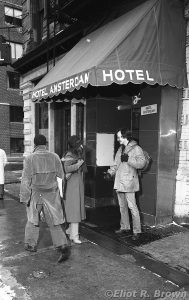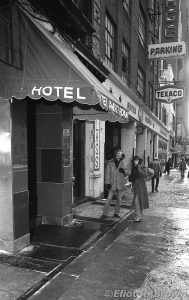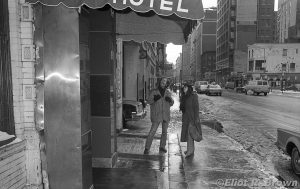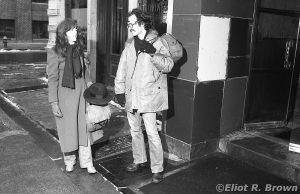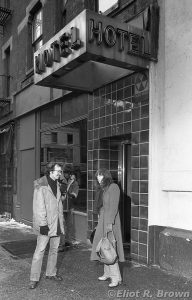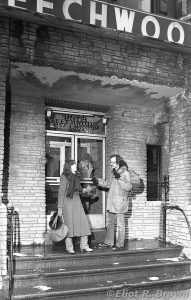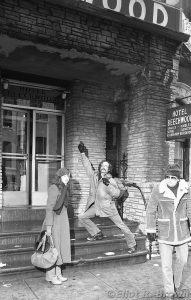Master story teller Denny O’Neil seemed to know every dive SRO [Single Room Occupancy—which meant “dive” back then, now it’s tony– Inner City Brown] in the lower Manhattan area. We hit three dumps within walking distance of each other, one, two, three. It’s hard to believe how rundown this area was – not all that long ago. In fact, Marvel moved down to that nabe only 3-4 years later. Yes we were over on Park Ave South, this was around Third Ave. But, c’mon!
So Assistant Editor Linda Florio and Assistant Editor Mark Gruenwald were being moved around by Puppeteer Denny. I tried for some coverage of each place.
We’ve seen the formerly awful Carlton Arms Hotel. Now for additional choice…
You might not know it, but I didn’t really do much outdoor photography at this point in time, urr… 1979. I had tried of course, but I had my eye on architectural photography, which to my background, made use of a so-called large-format view camera. During my childhood—and it must be said, even till today—that is still the tippy top of art-oriented photography. Mostly because the camera, lens and film all conspired to force both the camera and the subject to hold still. And buildings will do that. People, much harder. If you ever see Hollywood type glamor pix, they were shot with studio lights. Better known as major heat sources. I mean, you needed a LOT of light.
Except until the rise of flash photography (I’m not going way back to flash powder photography—you can thank me later). There’s two types. One is an actual light bulb filled with magnesium wire. That element is very volatile. Connect a little electricity to the flash bulb and it will make an explosive amount of light, just right to expose film with.
The electronic version is not as exciting but will do much the same. For this series of photos, I sought to balance the foreground and the background amounts of light. With a little emphasis on the foreground. This was made almost easy with an electronic flash unit—because it had a gadget that read the amount of light bouncing off the subject and switched off the flash in mid-fire. You could do all kinds of tricks with a flash unit. The most important one for me and for portrait photography was taking the flash unit off the camera.
This was expensive to do and finally having a salary with a bit of disposable income, allowed me to get a synch cable and super-duper power supply. Letting loose all those photons at once was a power hungry operation. Getting them to come out exactly when the camera shutter was open was the job of the synchronization cable.
Here’s where I should introduce Arthur “Weegee” Fellig, a very influential newspaper photographer from the early/middle last century. His style was turning everyday events, kids or punks, high society or murder victims, into a form of art. I encourage you all to look him up—within just a few of his photos you will see what I mean.
If you ever see the monster camera he carried, a “Speed Graphic” view camera, you will wonder how did he do it? My Nikon 35mm camera with its motor drive weighed over 4 pounds. A Speed Graphic weighs about 10—including the flash unit. The film in his camera is critical to consider—a 4×5 inch piece of film. But one that is large enough to easily hand process—which he did in a home-made “dark room” in the trunk of his car. (I did learn to process so-called cut film in a tray as well as 35mm roll film. Not for the faint of heart—film gets very slippery, don’t drop it! I did process the film for this series in Marvel’s slop sink—I can tell by the shameful water spots, but I had agitated the film enough to get a snappy, contrasty negative.)
I am hardly comparing myself to Weegee! But I was mindful of the harsh look of flash lighting which would have—should have raised up a recollection of Weegee. I did do one thing to reduce the crisp quality of light—I was thinking of Linda’s fair, damask-like skin and Gruenie’s fairly rugged skin. I attached a piece of white card stock to the back of the strobe. The Vivitar 283, which they should never have stopped making or trying to “improve” had a nice flat back and the flash head could be tilted from straight up to straight at the subject. By putting a piece of white card there, I increased the area of the flash light as it exited the opening. Thus softening that light just a little bit.
I am fairly certain that I used a specific kind of lens for this series. It was more of a wide-angle than I had at this point. And I always wanted wider! But this was also a perspective correcting lens. That afore-mentioned type of architectural specialty camera—well, Nikon figured out how to get that sort of effect for a 35mm film camera. I was delighted to have it—note that most of the up-and-down lines of the buildings are parallel. This means, I whipped the lens around for each shot.
“How much for the Fallout Shelter Suite?”
What the heck was this place? Aside from a choice spot for Denny to do his best Freelancer Payday impression! I only have a couple of shots in total of this spot so we must have been chased away.
There’s enough character in all of the main characters here. Frozen Innocence, Stayin’ Alive and Get Me The Hell Out Of Here. Oh yeah and Hotel de Dashed Hopes… which did come with an elevator!
End Part 2
